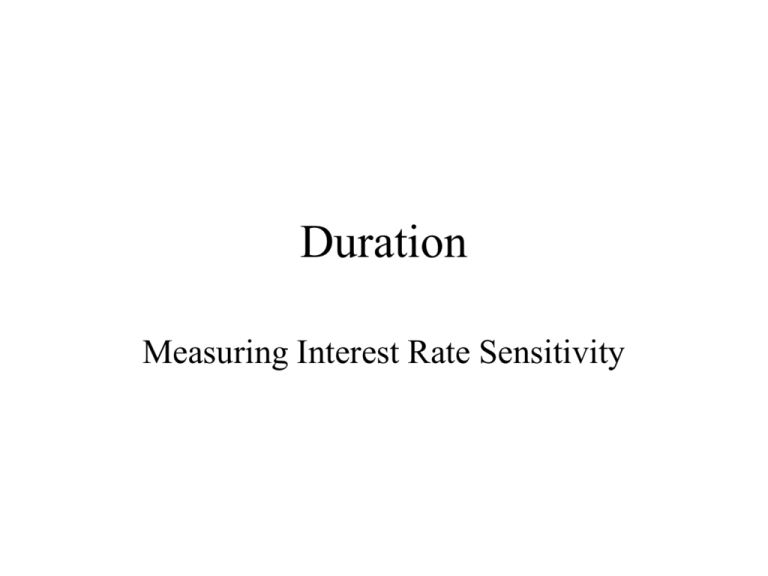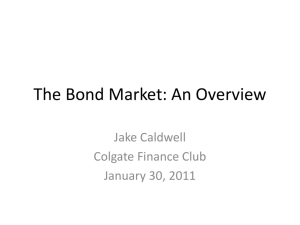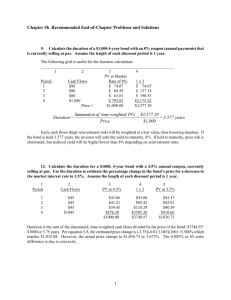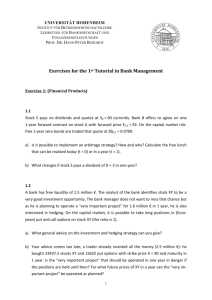Duration - KSU Web Home
advertisement

Duration Measuring Interest Rate Sensitivity Measuring Interest Rate Risk • We know: – An increase in interest rates causes bond prices to fall, and a decrease in interest rates causes bond prices to rise. • We also know that longer maturity debt securities tend to be more volatile in price. – For a given change in interest rates, the price of a longer term bond generally changes more than the price of a shorter term bond. Measuring Interest Rate Risk • Two bonds with the same term to maturity do not have the same interest-rate risk. – A 10 year zero coupon bond makes all of its payments at the end of the term. – A 10 year coupon bond makes payments before the maturity date. • Which bond has the highest interest-rate risk? Interest Rate Risk Problem • Calculate the rate of capital gain or loss on a ten year zero coupon bond for which the interest rate has increased from 10% to 20%. The bond has a face value of $1000. – Capital gain = (Pt+1 - Pt) / P t – - 49.7% = ($193.81 - $385.54)/$385.54 Interest Rate Risk Problem • The rate of capital gain or loss on a ten year coupon bond that has a face value of $1000 for which the interest rate has increased from 10% to 20% is -40.3%. • The interest rate risk on a ten year coupon bond is less than the interest rate risk on a 10 year zero coupon bond. • Why? Varying Coupon Rates: Coupon Effect • A security promising lower annual coupon payments behaves as though it has a longer maturity even if it is due to mature on the same date as a security carrying a higher coupon rate. – Investors must wait longer to realize a substantial return. • The farther in the future cash payments are to be received, the more sensitive the present value of the stream of payments to changes in interest rates. Coupon Effect: Definition • When interest rates rise, the prices of low coupon securities tend to fall faster than the prices of high coupon securities. • Similarly, when interest rates decline, the prices of low coupon rate securities tend to rise faster than the prices of high coupon rate securities. • Therefore, the potential for capital gains and capital losses is greater for low coupon securities. Duration: Introduction • Knowledge of the impact of varying coupon rates on security price volatility led to the development of a new index of maturity other than straight calendar time. • The new measure permits analysts to construct a linear relationship between term to maturity and security price volatility, regardless of differing coupon rates. Duration Present value of interest and principal payments from a security weighted by the timing of those payments D= n = Present value of the security’s promised stream of interest and principal payments CPt t S (1 + i)t t=1 n CPt S (1 + i)t t=1 Duration CP represents the expected payment of principal and interest income. n t represents the time period in which each payment is to be D = received. And i is the security’s yield to maturity. CPt t S (1 + i)t t=1 n CPt S (1 + i)t t=1 Duration Example Assume there is an investor who is interested in buying a $1,000 par value bond that has a term to maturity of 10 years, a 10 percent annual coupon rate, and a 10 percent yield to maturity based on its current price. D = $100(1) $100(2) ... $100(10) $1000(10) + + + + (1.10) (1.10)2 (1.10)10 (1.10)10 $100 + $100 + ... + $100 $1000 + (1.10) (1.10)2 (1.10)10 (1.10)10 = 6758.9 1000 = 6.758 years Duration: Zero Coupon Bonds Example • To get the effective maturity of a set of zero coupon bonds we must: – Sum the effective maturity of each zero coupon bond, weighting it by the percentage of the total value of all the bonds that it represents. • The duration of the set is the weighted average of the effective maturities of the individual zero coupon bonds, with the weights equaling the proportion of the total value represented bye each zero coupon bond. Duration: Example Yield = 10% Year Cash Payments 1 2 3 4 5 6 7 8 9 10 10 Total 100 100 100 100 100 100 100 100 100 100 1000 Present Value of Cash Payments 90.01 82.64 75.13 68.30 62.09 56.44 51.32 46.65 42.41 38.55 385.54 1000.00 Weights Weighted % of Total PV Maturity 0.09001 0.08264 0.07513 0.06830 0.06209 0.0.644 0.05132 0.04665 0.04241 0.03855 0.38554 1.00 0.09091 0.16528 0.22539 0.27320 0.31045 0.33864 0.35924 0.37320 0.38550 0.38550 3.85500 6.75850 Zero Coupon Bond Example: Steps • Calculate the present value of each of the zero coupon bonds when the interest rate is 10% (column 3). • Divide each of these present values by $1000 (the total present value of the set of zero-coupon bonds) to get the percentage of the total value of all the bonds that each bond represents. Note that the sum equals 1 (column 4). • Calculate the weighted maturities (column 5) by multiplying column 1 by column 4. • Get the effective maturity of the set of bonds by adding column 5. Duration: Another Example Yield = 20% Year Cash Payments 1 2 3 4 5 6 7 8 9 10 10 Total 100 100 100 100 100 100 100 100 100 100 1000 Present Value Weights of Cash Payments % of Total PV 83.33 69.44 57.87 48.23 40.19 33.49 27.91 23.26 19.38 16.15 161.15 580.76 0.14348 0.11957 0.09650 0.08305 0.06920 0.05767 0.04806 0.04005 0.03337 0.02781 0.27808 1.00 Weighted Maturity 0.14348 0.23914 0.29895 0.33220 0.34600 0.34602 0.33642 0.32040 0.30033 0.27810 2.78100 5.72204 Things to Notice • When the yield to maturity rises, the duration of the coupon bond falls. • The higher the coupon rate on the bond, the shorter the duration of the bond. • When the maturity of a bond lengthens, the duration rises as well. • Duration is additive: the duration of a portfolio of securities is the weighted-average of the durations of the individual securities, with the weights equaling the proportion of the portfolio invested in each. Duration is Additive • The duration of a portfolio of securities is the weighted average of the durations of the individual securities with the weights reflecting the proportion invested in each. – Example: Let 25% of a portfolio be invested in a bond with a duration of 5 and let 75% of the portfolio be invested in a bond with a duration of 10. • Dp = (0.25 x 5) + (0.75 x 10) = 8.75 years Duration and Interest Rate Risk • Because duration is related in linear fashion to the price volatility of a security, there is an approximate relationship between changes in interest rates and percentage changes in security prices. Duration and Interest Rate Risk % Change in the price of a debt security = -D x /\ i x 100% 1+i D = duration /\ i = change in interest rates % Change in the price of a debt security 0.02 x 100% = -11.91% = -6.55 x 1 + 0.10 An increase in interest rates of 2% causes a decline in the bond’s price of approximately 12%.









